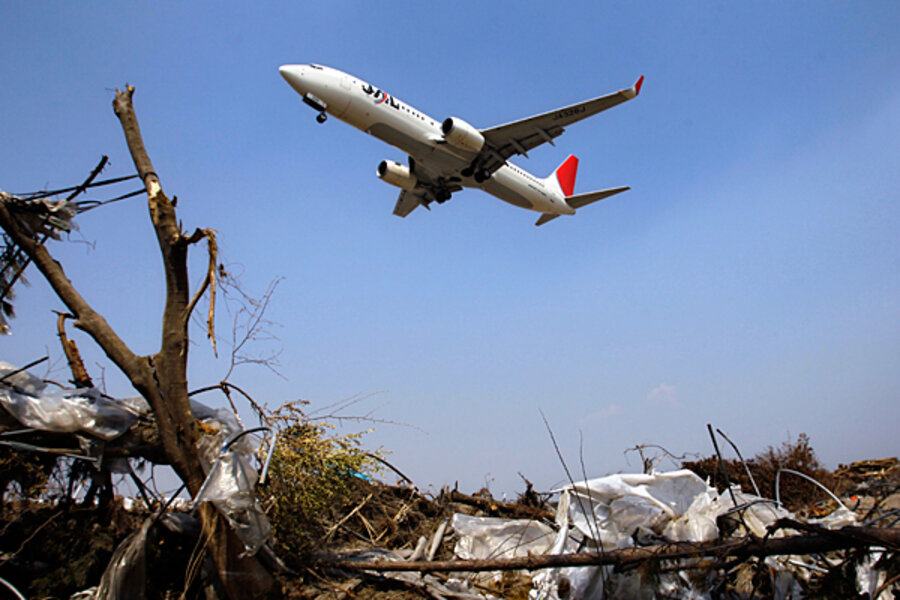Sendai Airport reopens, but Japan still lacks plan to end nuclear crisis
Loading...
This timeline will be updated with the latest nuclear developments in Japan.
Week 5, April 9 - April 13
April 13: Sendai Airport reopened for local flights today, more than a month after the 30-foot tsunami poured over the runways. Progress was also reported nearby at Fukushima Daiichi nuclear power plant, according to Reuters, despite tests showing increased radiation levels in the sea near the complex. Tokyo Electric Power Company, the plant operator, announced today it is still working on a blueprint to end the nuclear crisis. "As instructed by Prime Minister Kan, we are working out the specific details of how to handle the situation so they can be disclosed as soon as possible," Tepco's president told reporters at a news conference in Tokyo.
April 12: Japan raised the severity rating at Fukushima to level 7, the most serious on the international scale and the same rating that was given 25 years ago to Chernobyl. Tokyo Electric Power Company, the operator of Fukushima Daiichi nuclear power plant, said the crippled nuclear reactors may eventually leak more radiation than was released at Chernobyl.
April 11: It has been exactly one month since a 9.0 earthquake struck the northeast coast of Japan and triggered a 30-ft. tsunami that damaged a nuclear power plant. The country observed a moment of silence for the tens of thousands missing or dead in its worst crisis since World War II. Then, shortly after Japan widened the evacuation area around the damaged Fukushima Daiichi nuclear power plant, another substantial aftershock shook Japan, about 100 miles north of Tokyo. Japan's meteorological agency measured the temblor at 7.0, but a US agency said the quake was about magnitude 6.6. The latest quake halted cooling systems at the plant for about an hour as authorities continued to pump low-level contaminated water into the sea.
Meanwhile, safes that people used at home to store cash and valuables are washing up along the tsunami-battered coast, and police are trying to find their owners. About $350 billion worth of Japanese currency doesn't circulate, according to one estimate.
April 10: Some 2,000 people marched in Tokyo Sunday calling for Japan's nuclear power stations to be shut down. Tepco, the Tokyo Electric Power Company that operates the Fukushima facility, reported that a worker who was placing hoses to collect contaminated water from reactor No. 2 was taken to the hospital but that no radioactive substances were found on his body. He was treated for exhaustion.
April 9: Two of the world's largest concrete pumps – one from Los Angeles, and one from Atlanta – left the US for Japan to help pump water onto the damaged reactors from a safe distance. Tepco also apologized to the Japanese public for the nuclear crisis. A spokesman also said the company hoped to stop pumping radioactive water into the ocean by Sunday.
Week 4 , April 4 - April 8
April 8: China's Foreign Ministry said it is concerned about and will monitor Japan's actions to regain control of Fukushima, saying Tokyo must provide swift and accurate information to its neighbor.
April 7: A massive 7.1 aftershock struck northern Japan's Miyagi Prefecture. Workers temporarily evacuated Fukushima as tsunami advisories were issued and then lifted. Two out of three external power lines to the Onagawa nuclear power plant, 75 miles northeast of Fukushima and near the epicenter of Thursday's temblor, have been damaged, causing power loss. South Korea criticized the Japanese government for failing to notify its neighbor that it would pump radioactive water into the sea.
April 6: Emergency workers have managed to stop the radioactive water, measured at 7.5 million times the legal limit, from leaking out of the Fukushima Daiichi nuclear plant's reactor No. 2 and into the ocean, say officials. Plant operator Tepco is now concerned about a build-up of hydrogen inside reactor No. 1, which may mean the reactor's core is damaged. As a precautionary measure, officials say workers are preparing to inject nitrogen into the containment vessel to try to bring the reactor under control. Meanwhile, Japan's official spokesperson, Yukio Edano apologized to neighboring countries for not notifying them before they started pumping low-level radioactive water into the ocean this past weekend.
April 5: Tepco says it is continuing to pump millions of gallons of contaminated water, overflow from efforts to cool the Fukushima Daiichi nuclear power plant, into the sea. The move is to help cooling efforts as workers attempt to slow a major leak of highly radioactive water from the plant. Tepco says it has succeeded in slowing leaking water from the No. 2 reactor. However, the levels of radioactive contamination of caesium in fish are now exceeding health guidelines, increasing environmental and food safety concerns. Meanwhile, Japanese police have charged two people with selling a fake radiation protectant drug, according to investigators.
April 4: Tepco said some 11,500 tons of contaminated water would be released today in order to make room for more radioactive water storage. Authorities say they have still not found the source of a leak they believe is responsible for highly contaminated water levels near Fukushima.





